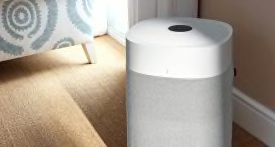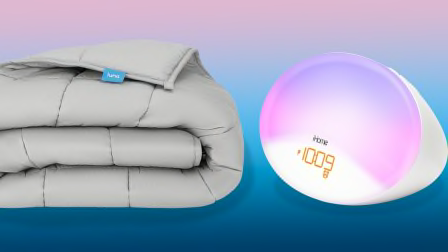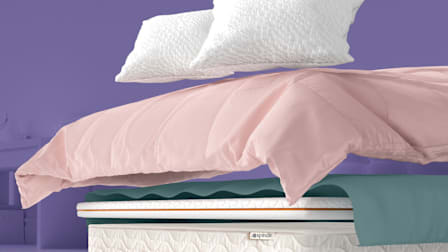Best Sunrise Alarm Clocks of 2025
If you’re tired of being jolted out of bed by your current alarm, a dawnlike wake-up light just might brighten your mornings in more ways than one. Here’s our take on five popular models.
When you shop through retailer links on our site, we may earn affiliate commissions. 100% of the fees we collect are used to support our nonprofit mission. Learn more.
Whether you struggle to get a good night’s sleep or are simply not a morning person, a sunrise alarm clock could be your new best friend.
Sunrise alarm clocks gently emit light at your designated time, glowing ever brighter like the rising sun, with the goal of gently rousing you from your slumber. Many give you the option of replacing the jarring sounds of a typical alarm clock with pleasant nature sounds, such as chirping birds, wind chimes, or even glorious silence. In short, they’re designed to create a natural-feeling alternative to the rude awakening offered by a conventional clock.
“Light is responsible for regulating our sleep-wake cycles,” explains Dr. Nilong Vyas, a board-certified pediatrician, sleep coach, and founder of the family sleep consulting service Sleepless in NOLA. “The type of light and the amount of lux [a measure of illuminance an object produces] can stimulate the retina of the eye and give signals to the body that it is time to wake up or go to sleep.”
@consumerreports Tired of being jolted out of bed by your current alarm? See the best sunrise alarm clocks from our tests through the link in our bio. #sunrisealarmclock #alarmclock #sleeptok
♬ original sound - Consumer Reports
Best Sunrise Alarm Clocks
To make a fair comparison, we limited our roundup to stand-alone devices with a clock interface. Ultimately we landed on popular models from six brands: hOmelabs, iHome, JALL, La Crosse, Lumie, and Philips. All have backup-battery capabilities (though a battery may or may not be included) that save the clock’s time and alarm settings in case of a power outage, or if the clock is accidentally unplugged.
Here, we list the clocks in order of how they fared in our evaluation, from most to least user-friendly. (This test did not assess brightness levels or light color or quality of the audio.) Prices below are approximate and may change.
Price: $40
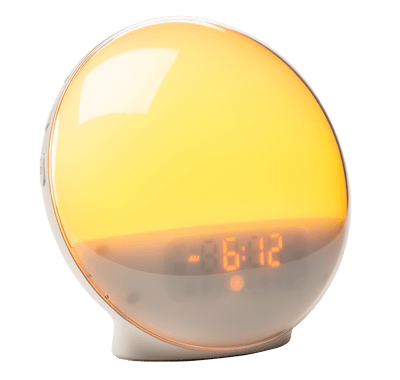

The JALL Wake Up Light Sunrise Alarm Clock is at least half the price of the Philips and the Lumie, but from an ease-of-use standpoint, this model comes out on top. It has two independent alarms (so you can set them for different times depending on your routine), seven alarm tones (including “wind bells” and birds chirping), an FM radio, and a fall-asleep mode that simulates a sunset (though no white-noise option). It was relatively easy to set up and use. According to the manufacturer, it emits a maximum light intensity of 240 lux. Tapping the snooze button will temporarily shut off both the light and the sound. (The advantage: You’re more likely to fall back asleep in the dark. The disadvantage? You’re more likely to fall back asleep in the dark.)
Buy at: Amazon
Price: $109
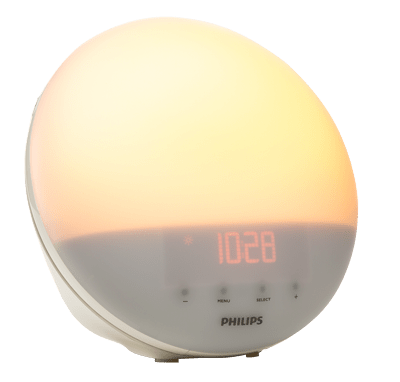

With the Philips SmartSleep Wake-up Light HF3520/60, you can wake up to one of five nature sounds or an FM radio. According to the manufacturer’s description, the clock glows with red, orange, and yellow colors that ultimately brighten to a maximum intensity of 300 lux (you can adjust brightness levels down, according to your preference). Pressing snooze will temporarily shut off the sound alarm but not the light, which may keep you from falling back asleep (a good thing, if you truly want to wake up). The SmartSleep is pretty easy to set up and use, receiving high marks in both categories. Those needing help winding down at bedtime will also find the Philips wake-up light worth it for its simulated sunset feature. (But for wind-down sounds and programs, you’ll need to upgrade to the HF3650 or HF3670.)
Price: $130
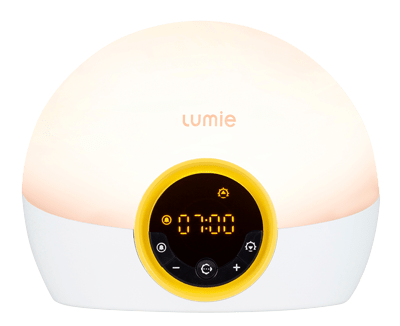

The Lumie Bodyclock Glow 150 has a simple, straightforward interface and an eclectic mix of 10 audio options, including plenty of nature sounds like tropical birds, crickets, or even goats. Silence is also an option, but an FM radio is not. Lumie’s light glows with dawn-inspired oranges and reds before its brightness level rises to an intensity of 500 lux, assuming it’s placed about a foot away on the nightstand, says the manufacturer. Unlike most sunrise alarm clocks, the Lumie is dome-shaped and emits light from its entire top side, not just from its face. When you tap snooze, both the light and audio alarms shut off. The Lumie also has a customizable sunset mode that can be used with soothing sounds, such as white noise, a thunderstorm, or ocean waves. You can program the light to fade out over 20, 30, or 45 minutes, or to stay on faintly for use as a nightlight.
Price: $60
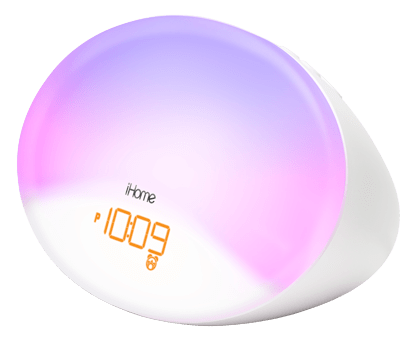

The iHome Zenergy Sunrise Bedside Therapy Machine (iZBT3) feels more like a great sound machine than a true sunrise alarm clock, thanks, in part, to its Bluetooth speaker. While it has a clock, a light alarm (with a maximum intensity of 300 lux from a foot away), and a choice of alarm sounds, we found that it’s hard to set up: The controls are confusing and the buttons don’t respond immediately. Fortunately, this device is easier to use once you’ve programmed it. Press snooze and you’ll temporarily halt the alarm sound and the light at the same time. This wake-up light’s best assets are, in fact, its sleep offerings, complete with 15 soothing tones (from melodies to nature sounds) and a guided breathing exercise. The iZBT3 also offers a sunset mode, though its inability to fade the light or sound gradually over time (it simply shuts off), may be jarring to some users.
Buy at: Abt
Price: $36
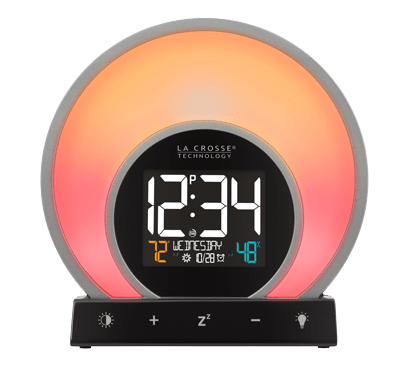

The La Crosse Soluna Light Alarm Clock features five light settings, including one that pulses for guided breathing exercises. In all, there are a total of 20 color settings. But when it comes to functionality, it falls a bit short. It has just one alarm sound (“melody”), one light alarm, and no FM radio or white-noise function. Worse, it’s challenging to set up. However, the display does show temperature and humidity—two contributors to sleep quality and something none of the other clocks offer. For those who prefer to will themselves awake, this clock helpfully leaves the light on when you press snooze, shutting off only the sound.
Buy at: Home Depot, LaCrosse Technology, Staples
Sunrise Alarm Clock You Should Skip
Price: $30
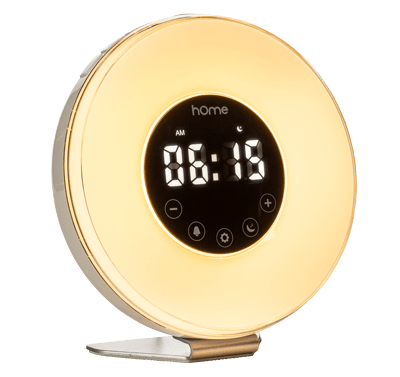

You can set only one wake-up alarm time with the hOmelabs Sunrise Digital LED Alarm Clock, though you have a choice of seven alarm tones (including birds chirping, ocean sounds, and an FM radio). The clock offers eight color options, but you can use only the white light for the sunrise-alarm feature. This sunrise alarm clock is one of the least expensive you’ll find, but its light (at 130 lux, according to the manufacturer) is considerably less bright than others on this list, and it’s not very intuitive to use (you may have to refer to the instruction manual every time you set it up, at least in the beginning). Tapping snooze will shut off the alarm sound, but the light will remain on. The hOmelabs also offers a dedicated sunset/sleep mode, with the option to fade the light out over 15, 30, or 60 minutes. This clock does not offer white noise.
Editor’s Note: If you encounter this alarm clock while shopping, you may notice its manufacturer name is off-brand. We expect these models to perform the same.
How Sunrise Alarm Clocks Work
Sometimes called wake-up lights, these devices gradually brighten over the course of a designated window of time (typically 10 minutes to two hours), before reaching its highest level of brightness at your desired wake-up time. Some higher-end sunrise alarm clocks emit light with colors resembling a natural dawn, incorporating more nuanced shades of yellow, orange, and red to wake you up.
How bright should sunlight alarm clocks be? Generally speaking, to effectively wake you up, a light should fill your room. While we didn’t measure the brightness of light intensity in this round of testing, we found that a manufacturer’s advertised intensity can vary from clock to clock.
The maximum brightness intensity of two of the devices we tested landed around the 300-lux range (measured from a distance that roughly approximates what’s between a sleeper’s eyes and the nightstand where the clock would presumably sit). The cheaper clock options fell below that. One clock in this round of testing emits 500 lux from about a foot away, according to the manufacturer. Another provided no information, even when we reached out to customer service.
Waking up with light, albeit artificial light, isn’t just helpful for people seeking a more pleasant way to start the day—it’s also great for those struggling with time changes like a transition from daylight savings to standard time, jet lag, or shift work.
“The impact can predispose the body to wake up as if it were receiving direct access to [sun]light,” says Girardin Jean-Louis, PhD, a professor of psychiatry and neurology at the University of Miami who has studied sleep equity for more than 20 years.
Of course, these devices aren’t a replacement for how refreshed you might feel after 7 to 8 hours of quality sleep. But for those who are not morning people, a sunrise alarm clock can be pretty good at helping them wake up more easily. (If you’re a heavy sleeper, make sure to set the clock for a wake-up sound along with the sunrise alarm.)
As one user told CR, “I have an extremely hard time waking up early for work. I also get seasonal affective disorder in the fall and winter. I noticed how my mood is greatly impacted by the sun and thought a sunrise alarm clock would help. It does.”
There may be some scientific evidence for this. While the effect of light on sleep and waking is still a relatively young field, research suggests that dawn simulation may be helpful. One study found that it may ease subjective feelings of grogginess. Another reported that adolescents experienced enhanced alertness, demonstrating significantly increased attention during computer tests when compared to a baseline.
How CR Assessed Sunrise Alarm Clocks
To better understand consumer needs in this area, Consumer Reports reached out to 15 sunrise-alarm-clock users to find out what they value in the products they own. Dana Keester, an engineer on CR’s Consumer Experience and Usability Research team, then used their responses to help organize a set of criteria with which to compare the popular models we chose to review. Each model was then scored according to:
Ease of setup: The clock should come with clear, simple instructions. The process should be easy to navigate and fairly intuitive. You should also be able to preview the settings (such as the alarm sounds and the brightness levels of the light).
Ease of use: Buttons and switches should be accessible and easy to maneuver. The time on the clock, indicators for alarm sounds and brightness levels, and other markings should be easy to read and understand. You should also have the freedom to customize the alarm settings (such as with light and sound).
Available features: Sunrise alarm clocks that scored well in this category include the three features that the users we interviewed found most desirable. Interestingly, two of those three features are sleep-related—namely, having a “wind-down” sunset mode and the option of white noise or nature sounds. The third feature is the ability to preset multiple alarms. This comes in handy if you wake up at different times on weekdays and weekends.
What About the Hatch Alarm Clock
We limited our assessment to models that (1) had a light that fades in as at least one of its primary sources of alarm, (2) had a clock face, and (3) the primary means of interaction was through the user interface on the product itself rather than an app. Because the Hatch Restore is an app-based sunrise alarm clock, it didn’t meet the criteria for our test.
Although the Hatch didn’t receive a formal evaluation for its sunrise alarm clock abilities, a team of evaluators did assess this model for its white noise feature. What they found is that the Hatch is a bit extra. First, you need to use the app to program its alarm and noise settings. (Did we mention the best way to get sound sleep is to keep your phone out of the bedroom?). But more annoyingly, you have to pay an annual fee to unlock the already pricey product’s full library of bells and whistles.
@consumerreports Tired of being jolted out of bed by your current alarm? See the best sunrise alarm clocks from our tests through the link in our bio. #sunrisealarmclock #alarmclock #sleeptok
♬ original sound - Consumer Reports











